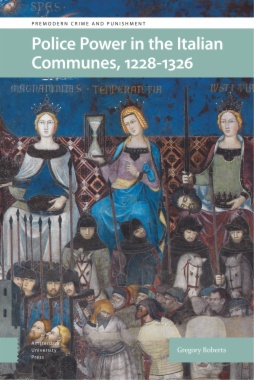Medieval states are widely assumed to have lacked police forces. Yet in the Italian city-republics, soldiers patrolled the streets daily in search of lawbreakers. Police Power in the Italian Communes, 1228-1326 is the first book to examine the emergence of urban policing in medieval Italy and its impact on city life. Focusing on Bologna in the thirteenth and early fourteenth centuries, Gregory Roberts shows how police forces gave teeth to the communes' many statutes through a range of patrol activities. Whether seeking outlaws in the countryside or nighttime serenaders in the streets, urban police forces pursued lawbreakers energetically and effectively. They charged hundreds of individuals each year with arms-bearing, gambling, and curfew violations, convicting many of them in the process. Roberts draws on a trove of unpublished evidence from judicial archives, rich with witness testimony, to paint a vivid picture of policing in daily life and the capacity of urban governments to coerce. Breaking new ground in the study of violence, justice, and state formation in the Middle Ages, Police Power in the Italian Communes sheds fresh light on the question of how ostensibly modern institutions emerge from premodern social orders.
- Cover
- Table of Contents
- Acknowledgments
- A Note on Usage
- Abbreviations
- Introduction
- Police as a Mode of Governance
- Police and Impersonal Rules
- The Plan of the Book
- 1. Police Power in the Italian Communes
- The Podestà’s Household
- Police Patrols and Inspections
- The Legal Process: From Detention to Trial
- A Comparison of Selected Data
- Conclusion: Policing and Hegemonic Justice
- 2. Police Discretion and Personal Autonomy
- Social Identity
- Political Status
- Factual Matters
- Legal Presumptions
- Police Jurisdiction
- Mitigating Factors
- Conclusion: The Paradox of Impersonality
- 3. The Logic of Third-Party Policing
- “To […] Pursue and Capture Outlawed Criminals”
- “To […] Search for Men Bearing Prohibited Arms”
- “Trustworthy Foreign Men”
- “The Good State of the Commune”
- Conclusion: A Preventive Police
- 4. External Threats: Policing Out-Groups and Criminality
- Judicial Violence
- The Public Interest
- Outlaws, Infames, and Men of Ill Repute
- Police Patrols as Dragnet
- The Role of Fama
- Conclusion: A Persecuting Society?
- 5. Internal Threats: Policing Violence and Enmity
- Enmity and Instability
- Policing Feud
- Toward a Monopoly on Violence
- Preventing Enmity
- Conclusion: Legislating in the Shadow of Violence
- 6. The Social Impact of Third-Party Policing
- Mandatory Rules
- Legal Literacy
- Fear of the Familia
- Violent Self-Help
- Police-Community Relations
- Public Corruption
- Legal Privilege
- Conclusion: A Legacy of Government Coercion
- Conclusion
- About the author
- Index
- List of Figures
- Table 1: Bologna: Persons Denounced per Semester
- Table 2: Bologna: Curfew Case Outcomes by Percentage
- Table 3: Bologna: Arms-bearing Case Outcomes by Percentage
- Table 4: Bologna: Gambling Case Outcomes by Percentage
- Table 5: Bologna: Total Amount of Penalties in Lire
- Table 6: Bologna: Case Type by Percentage of Total Cases
- Table 7: Bologna: Convictions, January–March 1256
- Table 8: Bologna: Crowns and Arms Fragment, April–October 1264
- Table 9: Perugia: Inventiones, January–December 1279
- Table 10: Perugia: Inventiones, January–August 1283
- Table 11: Perugia: Persons Convicted
- Table 12: Perugia: Persons Convicted by Percentage of Total Convictions
- Table 13: Siena: Convictions, 1305II
- Table 14: Siena: Convictions, 1306I
- Table 15: Siena: Convictions, 1306II
- Table 16: Siena: Total Convictions, 1305II–1306II
- Table 17: Orvieto: Convictions, November 1294–November 1295
- Image 1: The record of Carlo Baciacomari’s trial in the Crowns and Arms series. Archivio di Stato di Bologna.
- Image 2: Drawings of prohibited weapons on the cover of a Crowns and Arms register. Archivio di Stato di Bologna.

